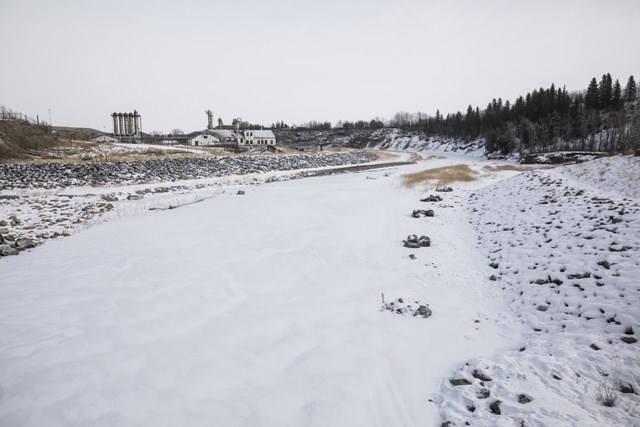Black Diamond and Turner Valley’s four-year struggle to obtain adequate water sources for 5,000-plus people is coming to an end.
Alberta Environment recently gave the Sheep River Regional Utility Corporation (SRRUC) the green light to proceed with a direct water intake in the Sheep River, which will put the amount of water supplied to both communities to the level it was before the 2013 southern Alberta flood destroyed most of their water sources.
Construction for the direct intake, which will pump water out of the Sheep River south of Turner Valley’s raw water reservoir, is expected to begin this spring and cost about $1.7 million.
Harry Riva-Cambrin, acting chief executive officer for SRRUC, said the approval came after many unsuccessful attempts to find adequate water sources for the two towns.
“We did a lot of well drilling upstream, mostly to see if we could find some more wells, but that was not successful,” he said. “In the end, we resorted to a direct intake and a stilling basin. The water from the river might be turbid at certain points of the year so it will be pumped into the stilling basin to allow the dirt to settle and then pumped into the reservoir.”
The Towns have been dealing with the situation since the flood washed away Black Diamond’s water treatment plant and all but two wells in the two municipalities.
Since then, the Disaster Recovery Program (DRP) funded an infiltration gallery, replacement wells and upgrades to Turner Valley’s water treatment plant to supply water to residents and businesses. Applications will be made to the DRP to fund this project as well.
Approval for the direct intake and stilling basin took about six months longer than anticipated, said Riva-Cambrin, when one of the key people involved with Alberta Environment died last year.
“By the time they got new people in place it took them a little while to get back on the files,” he said, adding work would have otherwise begun last fall.
Riva-Cambrin said a regional water system was in the discussion phase before the flood, as Black Diamond’s water treatment plan was in need of an upgrade.
The corporation was established to produce water for Black Diamond and Turner Valley, which is currently sold at wholesale price. Each Town owns 45 per cent of the corporation’s shares and the remainder is owned by the MD of Foothills, which is working on running a pipeline to Millarville to become a customer this year.
The Village of Longview, a silent partner, plans to join the corporation in future years.
Riva-Cambrin said the direct intake and stilling basin, once complete, should put the towns into normal operations.
“It’s just going to take another year or two before we finish constructing,” he said. “Work will start as soon as the weather allows.”
Black Diamond resident Garry McCarroll said a direct intake and stilling basin are not environmentally-friendly ways to draw water from the river.
“You have to go into the river and dig into the river bed and install a concrete structure into the river and install pumps in there,” he said. “That’s a lot of environmental impact on the river.”
McCarroll said withdrawing water this way creates suspended solids, hence the construction of the stilling basin. Wells, on the other hand, have a natural filter of gravel and dirt the water passes through.
“The best way to withdraw water from a river is to drill shallow wells into the gravel beds underneath the river,” he said. “That’s where most of the water comes from for Okotoks.”
Riva-Cambrin said SRRUC struggled to find wells in the Sheep River and some existing wells were abandoned because they were no longer producing due to low river levels and the river changing course.
“The wells have their own issue, in that water can only seep into them at a certain rate, whereas an intake is not impacted by that problem because you have the pump straight in the river so you are directly pumping water,” he said. “Your standard well would certainly have less of an impact, but a well associated with an infiltration gallery is the same as what we’re doing with the direct intake.”
Riva-Cambrin said he is happy with SRRUC’s most recent solution to the water situation.
“It’s a great project,” he said. “I think it’s going to serve the communities very well for a long time.”
Heather Thomson, Turner Valley interim chief administrative officer, said she is glad for Alberta Environment’s approval.
“It’s the final step in getting ourselves to the same position we were before the flood,” she said. “It’s a really great thing to get the water back.”
Since the flood, residents and merchants in Black Diamond and Turner Valley faced four years of water restrictions that limited outdoor water use. Several months following the flood and three weeks during last summer’s drought, outdoor watering was prohibited altogether.
“That doesn’t mean we will never go on water restrictions,” Thomson said, citing the towns could be faced with drought or fire in future years. “We have to be environmental stewards when it comes to our water. It’s our most precious resource and we would hope people would get on board with that.”




